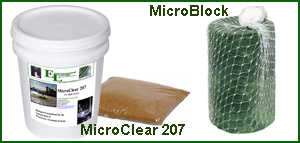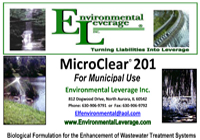Biological Products:
Bioaugmentation products for Wastewater applications in Papermills, Refineries, Chemical, Tanneries, Municipalities, Textiles, Steel, Agriculture, Animal feedlot, Gun Powder plant, Food and Beverage- Dairy Products, Orange Juice factory, Wineries, Cookie factory, Vegetable processing plant, Meat packing, Barbecue Restaurant, Aquaculture, Ornamental Ponds with algae , CAFO, Nursing homes, Military, Campgrounds, Universities, Regulatory agencies, River and Lake remediation
Lab Services:
Filamentous Identification Lab Service. One reason to identify filaments is to determine the filaments characteristics and then determine the type present. If the type is found out, a root cause can usually be associated with a particular filament. If the cause is known, then a correction can be made to alleviate problems. Chlorination is only a quick fix. Without process changes, filaments will grow back after chlorination. Wastewater Biomass Analyses and Cooling Tower Analyses also available
Training Materials:
Training is an integral part of any job. Not everyone is at the same level of training. Many people want beginning concepts and basics. Some need technical information or troubleshooting. Some want equipment, technology or process information. We have developed a full set of Basic training, Advanced training, Filamentous Identification the Easy Way as well as custom training CD's Manuals. We also provide hands-on training classes and soon will have an Online "E-University".
Audits and Consulting:
At Environmental Leverage® Inc., we have a team of experienced individuals who come into your plant with a fresh pair of eyes. The system is checked from influent to effluent. System optimization, equipment efficiency and operational excellence are key components explored. Key Benefits Equipment efficiency Total Cost of Operation reductions Reliability and safety An onsite audit is conducted to examine system parameters, process controls, and current monitor and control procedures. A physical walk-through is conducted, process flow diagrams are examined, previous design criteria are examined and current standard operating procedures are evaluated along with data logs.
|
Service OptionsLatest News!
What's New!
We have just added "Virtual Audits" to our capabilities. Check out our new Services. We are in the process of developing new courses for our ""Online E-University" in order to meet the needs of our global customers that cannot travel to our public classes.Visit our new website www.WastewaterElearning.com/Elearning Bioaugmentation Math
Yes, we agree with you. In the past there were tons of misconceptions about biological products. There were many companies trying to sell biological products. There were tons of companies trying to manufacture products. There were many names, different types of products, totally different recommendations on dosing and pricing seemed like it was picked out of a hat. Bioaugmentation reps had a worse reputation than car salesmen.
It was perpetuated by the fact that the biological portion of a wastewater system seemed like the mystery black box. Engineers who were comfortable with numbers could evaluate other parts of the system. You could measure flow, pumps, hydraulics, loading, or many other variables in and around a system. Those darn little bugs just did not follow any real math. So many engineers and operators were not really fond of the biological portion of the system. Many times polymers and chemicals were used as Band-Aids to overcome any deficiencies in the biological portion. There was not a lot of easy to follow training on the biological portion of the system either. A lot of the training was at a highly technical level and many operators were overwhelmed at what appeared to be a daunting task to understand what was going on in their system.
Many companies popped up 20-30 years ago selling biological products. Overdosing occurred and was often abused since some of the sales reps could take advantage of the lack of understanding of the biological portion of the system. They assumed the sales rep knew more than they did, believed them and often over purchased products and then were often disappointed in the results.
Here are a few quick and easy things to remember no matter where you
purchase products from:
Basic Steel (coke): 1.0:0.15 Petroleum Refining 1.0:0.35 Chemical Process 1.0:0.35 Sanitary (Municipal) 1.0:0.3-0.5 Pulp & Paper 1.0:0.5 Brewing 1.0:0.6 Food Processing 1.0:0.7
You can use bacteria in an old sludge lagoon to reduce solids, but it is more a matter of old leftover organic material that has built up and by using selected bacterial products, you can reduce some of the solids to avoid dredging as often. Sooner or later though, all lagoons will need to be dredged. There will be some solids accumulation.
2.) No matter which bacteria you use, whether the indigenous bacteria already in your system, liquid or dry cultures from a supplier, all bacteria require a minimum amount of steady conditions we call the "Critical 5 plus One". Bacteria are not Superbugs- they all need these conditions monitored or they will not work correctly.
There are 5 critical measurements that should be monitored and controlled to effectively run a biological treatment plant efficiently; Temperature, DO, Ammonia, Ortho-phosphate and pH.
Acceptable
environmental parameters for biological activity including:
PARAMETER
ACCEPTABLE
OPTIMUM Dissolved Oxygen
>0.5 mg/l
1.0 - 2.0 mg/l Temperature
50 - 95° F
77 - 95 ° F pH
7.0 - 9.0
7.5 - 8.5 Ammonia Residual
1.0 - 3.0 mg/l
2.0 - 3.0 mg/l Ortho-phosphate
Residual
0.5 - 2.0 mg/l
1.0 - 2.0 mg/l
·
Residual
should be measured in the final effluent.
**Alkalinity is the "plus one" and is required for systems that nitrify.
If you have an activated sludge plant, many times minor process changes coupled with close monitor and control of the biomass can help quicken upset recovery or just increase process efficiency. Not all plants need biological additives. Some just need to improve the "critical 5" parameters.
3.) Bacteria can come in many different sizes, shapes or formulations. There may be dry formulations, liquid, or Blocks. The reason they are made in different formulations is usually just for ease of application. General rule of thumb, dry products are almost always more concentrated and you get more of the bacterial formulation for your money instead of paying for liquid carrier. You must consider handling concerns and application though when choosing a product. Be careful about biological counts. Numbers are not as important as types- check out handout on evaluation of biological products.
4.) Application of bacteria can significantly improve many systems. Although many believe that there already are bacteria present in a system, so why should you supplement with more bacteria when you can grow your own? That may be true, there are bacteria in a system, but are they the right type and are they sufficiently achieving what your plant needs to accomplish. If your plant is currently meeting BOD and TSS permits, solids handling is not a problem, there are not filaments or foaming and everything is running the best it possibly can, then no bioaugmentation is not needed.
There is a saying, if it isn't broken, don't fix it. We agree. They only reason to add bacterial supplements is when the plant may be over designed, under designed, having a hard time meeting permits, solids handling costs are too high, grease from lift stations is causing problems, Foaming or filaments are a problem. There has to be a need and a problem that might benefit from the bacteria in order to justify the cost of supplementing a system. If significant returns on investment can be achieved, then bioaugmentation definitely should be looked into.
5.) Applications of biological products- Biological products are used for
many different reasons.
Filamentous control, foaming, grease reduction are areas where bioaugmentation can be used for short periods of time until process changes can be implemented long term to solve the problems. Under- designed plants or older plants where new growth in a community is faster than building new plants are often applications where biological products are used for only a period of time. Some plants only use biological products during the winter (colder) months when activity of the biomass slows down due to temperature drops (biological activity can drop one log growth for each 10 degrees). Many food or industrial plants that have pretreatment permits use biological permits to lower their surcharges. There are many applications for use of biological products. Make sure the cost justifies the return.
6.) Why use biological products when there is always a plant down the street that I can just go borrow sludge from? The biosolids from a plant are not free- the cost of trucking and handling sometimes are more than the cost of prepared biological cultures. There are no pathogens, filaments, zooglea, tetrads, inorganic debris or other variables that might be present in sludge from a neighboring plant. With commercial cultures, the products are highly concentrated, stable, and can actually be "grown up" prior to application, which greatly enhances the cost-effectiveness.
7.) You cannot buy "higher Life forms" These are indicator organisms.
They show up in a system and disappear according to the health and age of
the biomass. The bacteria in the system perform 98% of all BOD removal; not
the little critters that people often assume are working in the system. See
attached sheet on higher life forms evaluation. List of Bioaugmentation products
Links to Additional Troublehsooting Pages For More information on Products:Biological Products, Descriptions, Usage and Applications Case HistoriesBiological Products for use in Wastewater Applications for Bioengineering and Bioaugmentation
Biological Wastewater Treatment Products
How are your bugs doing?
The Most Comprehensive
Filamentous Bacteria Training Program you will find
|





